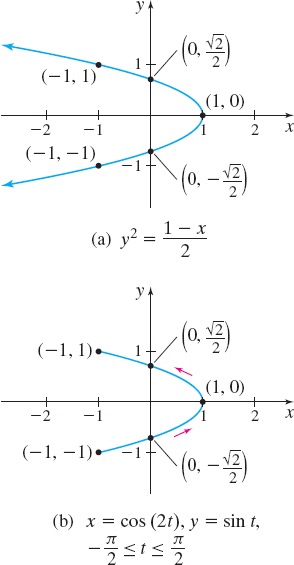EXAMPLE 4Finding a Rectangular Equation for a Plane Curve Represented Parametrically
(a) Find a rectangular equation of the plane curve whose parametric equations are x(t)=cos(2t)y(t)=sint−π2≤t≤π2
(b) Graph the rectangular equation.
(c) Determine the restrictions on x and y so the graph corresponding to the rectangular equation is identical to the plane curve described by x=x(t)y=y(t)−π2≤t≤π2
(d) Graph the plane curve whose parametric equations are x=cos(2t)y=sint−π2≤t≤π2
Solution (a) To eliminate the parameter t, we use a trigonometric identity that involves sint and cos(2t), namely, sin2t=1−cos(2t)2. Then y2=↑y(t)=sintsin2t=1−cos(2t)2=↑x(t)=cos(2t)1−x2
(b) The curve represented by the rectangular equation y2=1−x2 is the parabola shown in Figure 6(a).
(c) The plane curve represented by the parametric equations does not include all the points on the parabola. Since x(t)=cos(2t) and −1≤cos(2t)≤1, then −1≤x≤1. Also, since y(t)=sint, then −1≤y≤1. Finally, the curve is traced out exactly once in the counterclockwise direction from the point (−1,−1) (when t=−π2) to the point (−1,1) (when t=π2).
(d) The plane curve represented by the given parametric equations is the part of the parabola shown in Figure 6(b).
